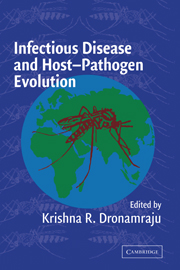Book contents
- Frontmatter
- Contents
- List of Contributors
- Introduction
- PART ONE J. B. S. HALDANE
- PART TWO MALARIAL PARASITES
- PART THREE OTHER PARASITES
- PART FOUR GENETIC AND EVOLUTIONARY CONSIDERATIONS
- 11 The Evolution of Pathogen Virulence in Response to Animal and Public Health Interventions
- 12 Infection and the Diversity of Regulatory DNA
- 13 Genetic Epidemiology of Infectious Diseases: The First Half-Century
- 14 The Impact of Human Genetic Diversity on the Transmission and Severity of Infectious Diseases
- 15 Evolution and the Etiology of Diabetes Mellitus
- 16 The Future of Human Evolution
- Index
- Plate Section
- References
13 - Genetic Epidemiology of Infectious Diseases: The First Half-Century
Published online by Cambridge University Press: 10 August 2009
- Frontmatter
- Contents
- List of Contributors
- Introduction
- PART ONE J. B. S. HALDANE
- PART TWO MALARIAL PARASITES
- PART THREE OTHER PARASITES
- PART FOUR GENETIC AND EVOLUTIONARY CONSIDERATIONS
- 11 The Evolution of Pathogen Virulence in Response to Animal and Public Health Interventions
- 12 Infection and the Diversity of Regulatory DNA
- 13 Genetic Epidemiology of Infectious Diseases: The First Half-Century
- 14 The Impact of Human Genetic Diversity on the Transmission and Severity of Infectious Diseases
- 15 Evolution and the Etiology of Diabetes Mellitus
- 16 The Future of Human Evolution
- Index
- Plate Section
- References
Summary
INTRODUCTION
The discovery of blood groups by Landsteiner (1900) coincided with the rediscovery of Mendelism. During the next generation, immunology and genetics developed together, but the ideas and even the vocabulary that are essential today were slow to evolve. The term population genetics was not used by Fisher, Wright, or Haldane but was introduced by C. C. Li (1948) in his magisterial synthesis that anticipated division of the field into what we now call evolutionary genetics and genetic epidemiology. Neel and Schull (1954) devoted a chapter of their book to epidemiological genetics, which evolved into genetic epidemiology to reflect the dual origins of disease (Morton et al., 1967). A characteristic of the time was that definitions appeared first in books rather than in articles. However, the pace quickened as human genetics rose from the ashes of eugenics. Haldane (1949) suggested that thalassemia minor might be protective against malaria. The young regional societies of human genetics and the first international congress of human genetics were excited by critical evidence for the link between hemoglobin S and falciparum malaria (Allison, 1954). At the same time, Watson and Crick (1953) created molecular biology, which provided the techniques and markers for genetic epidemiology of infectious disease. The essential vocabulary was slowly invented: linkage disequilibrium (Ohta and Kimura, 1969), haplotype (Ceppellini et al., 1967), diplotype (Morton, 1983), and linkage disequilibrium unit or LDU (Maniatis et al., 2002).
ABO BLOOD GROUPS
Fifty years ago polymorphisms were generally thought to be rare and maintained by selection.
- Type
- Chapter
- Information
- Infectious Disease and Host-Pathogen Evolution , pp. 307 - 314Publisher: Cambridge University PressPrint publication year: 2004



